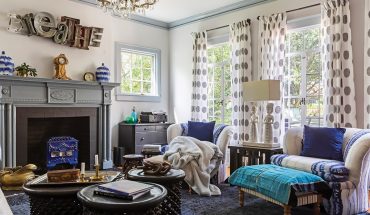 by P. Gaye Tapp
by P. Gaye Tapp
photographs by Leslie Baker
Today a formerly derelict Queen Anne-style Victorian house on the corner of North Blount and Peace streets has a new lease on life. Holy Trinity Anglican Church has painstakingly renovated the 114-year-old home for its new administrative offices, and its rector, the Rev. Dr. John Yates III, calls the project a work of redemption.
“We have taken something battered and broken and redeemed it,” he says.
The 350-member church purchased the historic Jordan House in autumn 2010 and began exhaustive renovations, completed this summer. The project involved a corps of parishioners, led by project manager Jim Baker of Fountainhead Design & Build and general contractor Howard Moye of Moye Construction.
Their work has received accolades, including an Anthemion Award from Capital Area Preservation for “outstanding dedication and commitment to excellence in historic preservation.”
Built about 1898 for Dr. Thomas M. Jordan, a distinguished Raleigh physician, Jordan House originally sat on the corner of North Wilmington and Peace streets. It was moved in 2008 to its new corner as part of Blount Street Commons, a six-block project that aims to revitalize the city’s 19th century historic houses and create a vibrant new neighborhood in downtown Raleigh.
“Everyone involved knew without a doubt that this was the right place,” Yates says. “A home in the center of the city.”
When Holy Trinity took ownership, the house’s exterior required a thorough overhaul, and the interior needed to be gutted. It had been divided into five apartments, some original floors were badly damaged, fireplaces had been bricked in, and almost all of the millwork needed to be replaced.
Moye Construction set out to restore the original configuration of the house and was able to preserve much of the original flooring and some of the original doors, creating new custom millwork to match the original throughout the house.
Two graceful front parlors and a library were restored to their original locations downstairs, anchored by a large central hall. A kitchen and new back porch were added to the rear of the house. Upstairs, five large offices were created, while the third floor remains unfinished.
The job of furnishing the almost 4,500-square-foot house relied entirely on volunteers and donations. With the help of a committee of interior designers – again, all parishioners – Jordan House was decorated with striking antiques, traditional furniture, and sisal rugs. With the church’s premise of “ask, and it shall be given you; seek, and ye shall find; knock, and it shall be opened unto you,” all was directly donated or purchased by church parishioners, or donated by friends.
The house’s newly elegant interiors are now matched by the its restored façade. After returning the original narrow clapboards to pristine condition, the house was painted a crisp ivory and the woodwork a bright white. With a tall, slate-shingled, hipped roof, an expansive veranda that wraps the front and side of the house, and an octagonal pavilion with a bell-curved roof that hugs the corner, Jordan House has been restored to much of its original glory.
The finished house is flooded with natural light, just one of the rector’s favorite aspects of his new home away from home. He calls the library “a haven in the midst of the busy house,” and it’s a favorite of parishioners as well, who have created a borrowing library in its built-in bookcases.
A large chandelier illuminates the round mahogany table in the center of the room. The table came from the Tucker House several blocks south on Blount Street, “where my grandmother Sue Tucker Yates grew up in the early 20th century,” he says. Another cherished space is his private study tucked away upstairs and furnished with an old lectern and pulpit restored by a parish member. The sturdiness of the old furniture grounds him. “I like to stand at these heavy oak pieces, working on my feet with laptop and open books all around, while stealing glimpses out the west-facing window, overlooking the rest of our property and an endless commotion of construction vehicles.” Holy Trinity has purchased the property next door and plans to build a church there.
In the meantime, Jordan House is the site of countless meetings and church functions. “The house is never quiet – and we are grateful for that!” Yates says.
As he and his parishioners anticipate breaking ground on their new church campus, Yates says his view of the capitol dome to the south, the tower at Broughton High School due west, and the beautiful red brick of William Peace University across the street keeps his mission in focus. “This view serves as a constant reminder of the vibrant city in which we live and of the extensive opportunities we have to serve.”




